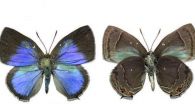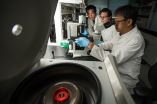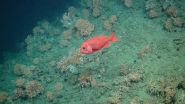Restoring ocean health
A UCSB analysis of 10 years of monitoring data from marine protected areas in the Channel Islands finds positive results
2015-09-16
(Press-News.org) More than a decade ago, California established marine protected areas (MPAs) in state waters around the northern Channel Islands off the coast of Santa Barbara. Several years later, the National Oceanic and Atmospheric Administration (NOAA) extended these MPAs into the federal waters of the Channel Islands National Marine Sanctuary.
To evaluate whether the MPAs are meeting their ecological goals, marine scientists from the Partnership for Interdisciplinary Studies of Coastal Oceans (PISCO) have been monitoring these rocky reef and kelp forest communities. Three UC Santa Barbara PISCO scientists have now published an analysis of 10 years of monitoring data for the MPAs in the Channel Islands network. The results appear in the journal Scientific Reports.
"The Channel Islands MPAs appear to be fulfilling their role as refuges for many fish and invertebrate species," said lead author Jennifer Caselle, a research biologist at UCSB's Marine Science Institute (MSI). "2013 marked the 10-year anniversary of the Channel Islands MPAs. A snapshot view in 2008 indicated that the MPAs were enhancing ecological communities, but we didn't have enough data to assess the long-term changes. Now, for the first time, we can compare long-term trends in the protected areas with areas open to fishing."
After the first five years of protection, scientists found that fish species targeted by fishermen had both greater density (numbers of fish per area) and biomass (total weight per area) inside MPAs as compared to reference sites outside -- and this was still true in 2013. "We expected to find an increase in biomass inside the MPAs for fish species that are the targets of fishing, and that did occur across the MPA network," Caselle said. "Perhaps more important, we also found increases in fished species outside in the unprotected areas. That means that one of the most common fears of fishermen was not realized -- and that's huge."
According to co-author Robert Warner, when fishing is prohibited in one area, fishermen naturally turn their attention to less protected areas. "It was feared that this extra effort would deplete the fish stocks outside of MPAs," noted Warner, a research professor in UCSB's Department of Ecology, Evolution, and Marine Biology. "Happily, there is no evidence of depletion. In fact, fish stocks outside of MPAs have increased over time, although at a slower rate than inside MPAs."
The scientists don't know if fish population increases beyond the MPA borders are related to reduced fishing pressure, spillover from MPAs, favorable environmental conditions or a combination of all three.
This study represents one of the first opportunities marine biologists have had to examine a network of MPAs rather than a single location. Even though the northern Channel Islands comprise a relatively small geographical space, the data showed spatial variation. The responses were strong in the eastern part of the channel but negligible in the west, where waters are colder.
"The northern Channel Islands lie within a transition zone where cold waters from the north meet warm waters from the south," said co-author Andrew Rassweiler, an MSI assistant research biologist. "Distinct groupings of marine life are associated with different parts of this spectrum of water temperatures throughout the islands, and these diverse areas can respond differently to the establishment of MPAs."
In warmer water surrounding the eastern islands, biomass of targeted species was higher within MPAs compared to areas outside. In contrast, at San Miguel Island, where MPAs are located in colder waters, the biomass of targeted species showed no significant difference between the MPA and unprotected areas. According to Caselle, these dissimilar responses could be due to differences in the amount of fishing across the islands combined with differences in growth rates of the animals.
"The implications of this are important because the state of California has recently implemented a statewide network of MPAs though the Marine Life Protection Act," she said. "We now have a large number of MPAs in a variety of habitats and ocean conditions. Our work in the Channel Islands creates expectations for what will be seen throughout the state. All MPAs are not going to perform equally.
"By following the trajectories of protected and unprotected areas through time and across space, we've been able to document the effects of MPAs in unprecedented detail," Caselle concluded. "This is the sort of information that management desperately needs."
INFORMATION:
Primary funding for this work was provided by the David and Lucile Packard Foundation and the Gordon and Betty Moore Foundation. Additional funding and/or vessel time was provided by Channel Islands National Park; NOAA; the California Ocean Protection Council; the Resources Legacy Fund; the National Science Foundation and the National Marine Fisheries Service via the CAMEO program; California Sea Grant; the Channel Islands National Marine Sanctuary; and the California Department of Fish and Wildlife.
ELSE PRESS RELEASES FROM THIS DATE:
2015-09-16
ATLANTA -September 16, 2015- While cancer is the second leading cause of death overall in the United States, it remains the leading cause of death among U.S. Hispanics. The finding comes from "Cancer Statistics for Hispanics/Latinos," a comprehensive report produced every three years by the American Cancer Society and published in CA: A Cancer Journal for Clinicians.
Hispanics/Latinos represent the largest racial/ethnic minority group in the United States, accounting for 17.4% of the total U.S. population in 2014. In 2015, 125,900 new cancer cases and 37,800 cancer deaths ...
2015-09-16
DARIEN, IL - A new study of twins suggests that insomnia in adults is partially explained by genetic factors, and this heritability is higher in females than in males.
Results show that the genetic influences on insomnia symptoms in adults were substantial and largely stable over time while differing significantly by sex. In the longitudinal model, the estimated heritability of insomnia was 59 percent for females and 38 percent for males.
"This study indicates that genes may play a larger role in the development of insomnia symptoms for women than for men, providing ...
2015-09-16
Female butterflies generally choose among male suitors, but in the tropics with hundreds of close relatives living in close proximity, how can they decide which males are the right ones? After all, if she mates with a male of another species, she is unlikely to have surviving offspring. One solution is that males of some species have scent producing organs on their wings, so if a male has the right smell, the female will presumably be receptive to his advances. Strangely, males of some species lack these scent producing organs, which would seem to be a huge disadvantage. ...
2015-09-16
EAST LANSING, Mich. - Researchers at Michigan State University were part of a team to discover a new natural defense against HIV infection.
The team's discovery, featured in the current issue of the Journal of Biological Chemistry, focuses on ERManI, a protein that prevents the HIV virus from replicating.
"In earlier studies, we knew that we could interfere with the spread of HIV-1, but we couldn't identify the mechanism that was stopping the process," said Yong-Hui Zheng, MSU associate professor of microbiology and molecular genetics and co-author of the study. "We ...
2015-09-16
NEW YORK - September 16, 2015 - EcoHealth Alliance, an environmental health nonprofit organization that focuses on local conservation and global health issues, announced the creation of the first centralized repository to collect data on the biological diversity in Bolivia. EcoHealth Alliance Senior Scientist, Carlos Zambrana-Torrelio, in collaboration with Miguel Fernandez from the German Centre for Integrative Biodiversity Research in coordination with more than 40 Bolivian scientists worked together to create the unique repository. The value of a biological repository ...
2015-09-16
LAWRENCE -- A new study based on longitudinal data confirms a college degree provides an advantage in lifetimes earnings, but a related decision once students make it to college could prove to be even more crucial.
The study that includes a University of Kansas researcher found large lifetime earnings gaps depending on a student's field of study. For examples, men who major in science, technology, engineering and mathematics, or STEM fields, and earning a bachelor's degree achieved roughly $700,000 to $800,000 higher 40-year lifetime earnings from ages 20 to 59 than social ...
2015-09-16
The incidence of the most common strain of Methicillin-resistant Staphylococcus aureus (MRSA) infections has decreased in hospital-onset cases, but has failed to decline in the broader community, according to new research published online today in Infection Control & Hospital Epidemiology, the journal of the Society for Healthcare Epidemiology of America.
The USA 300 strain of MRSA, has become prevalent in both communities and healthcare institutions. "In looking at risk factors for hospital or community-onset USA 300, current or former drug use was a strong predictor ...
2015-09-16
Amsterdam, September 16, 2015 - Targeted cancer treatments, toxicity sensors and living factories: synthetic biology has the potential to revolutionize science and medicine. But before the technology is ready for real-world applications, more attention needs to be paid to its safety and stability, say experts in a review article published in Current Opinion in Chemical Biology.
Synthetic biology involves engineering microbes like bacteria to program them to behave in certain ways. For example, bacteria can be engineered to glow when they detect certain molecules, and ...
2015-09-16
Washington -- A new analysis by the Synthetic Biology Project at the Wilson Center finds the Defense Department and its Defense Advanced Research Projects Agency (DARPA) funds much of the U.S. government's research in synthetic biology, with less than 1 percent of total federal funding going to risk research.
The report, U.S. Trends in Synthetic Biology Research, finds that between 2008 and 2014, the United States invested approximately $820 million dollars in synthetic biology research. In that time period, the Defense Department became a key funder of synthetic biology ...
2015-09-16
The first true three-dimensional picture of submarine canyon habitats has been produced using a unique combination of marine robotics and ship-based measurements. The information captured in this new set of maps ranges in scale from the 200km canyon down to the size of an individual cold-water coral polyp, and will be used to inform the management of the only English Marine Conservation Zone in deep water.
This 'nested map' is the result of a recent scientific expedition to the Whittard Canyon in the Bay of Biscay, led by the National Oceanography Centre (NOC). It works ...
LAST 30 PRESS RELEASES:
[Press-News.org] Restoring ocean health
A UCSB analysis of 10 years of monitoring data from marine protected areas in the Channel Islands finds positive results


